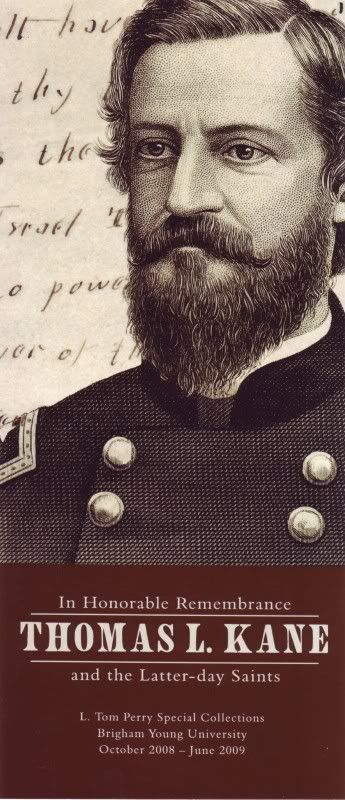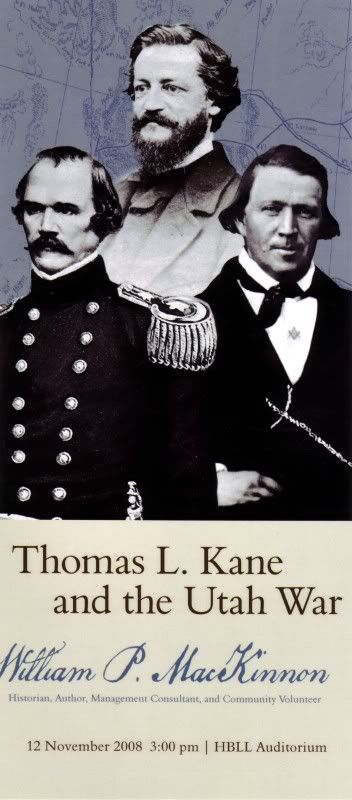 David J. Whittaker, curator of Mormon and western materials for L. Tom Perry Special Collections at BYU’s Harold B. Lee Library, has organized an exhibition and lecture series featuring the Thomas L. and Elizabeth W. Kane papers now housed at BYU.
David J. Whittaker, curator of Mormon and western materials for L. Tom Perry Special Collections at BYU’s Harold B. Lee Library, has organized an exhibition and lecture series featuring the Thomas L. and Elizabeth W. Kane papers now housed at BYU.
Last Wednesday’s (November 12) lecture by Bill MacKinnon was the first of the series I had been able to attend (see this Juvenile Instructor post for the listing of past and future entries in the series). The lecture was held in the Lee Library auditorium; I estimate that about 150 people were there. The lecture was taped for future broadcast on KBYU. David J. Whittaker introduced Bill like the old friend that the two of them are, and Bill gave his lecture, entitled “Thomas L. Kane and the Utah War: BYU’s Kane Collection as Lodestone.”
 Bill first defined the Utah War and outlined Kane’s role in it. (I’m taking it for granted that Keepa’s regular readers have a general idea of both the course of the War and Kane’s role, but if anyone is shaky about that, please don’t be embarrassed about saying so. I’ve given a few public addresses in the past couple of years geared toward bringing everybody up to speed so that nobody needs to be embarrassed; I could post the text of one of those “primers” if it would be useful.) Some of the points that Bill included were that “it was President James Buchanan’s 1857 effort to replace Brigham Young as governor of Utah Territory and to install his successor with an army escort of 2,500 troops”; tensions leading to the confrontation had been building almost since the 1847 pioneer arrival; it had nothing to do with polygamy, and little to nothing to do with Mormon rebellion; and the term “Utah War” is now the accepted, scholarly label, replacing the army-centric “Utah Expedition” and Utah-centric “Johnston’s Army” and other parochial terms.
Bill first defined the Utah War and outlined Kane’s role in it. (I’m taking it for granted that Keepa’s regular readers have a general idea of both the course of the War and Kane’s role, but if anyone is shaky about that, please don’t be embarrassed about saying so. I’ve given a few public addresses in the past couple of years geared toward bringing everybody up to speed so that nobody needs to be embarrassed; I could post the text of one of those “primers” if it would be useful.) Some of the points that Bill included were that “it was President James Buchanan’s 1857 effort to replace Brigham Young as governor of Utah Territory and to install his successor with an army escort of 2,500 troops”; tensions leading to the confrontation had been building almost since the 1847 pioneer arrival; it had nothing to do with polygamy, and little to nothing to do with Mormon rebellion; and the term “Utah War” is now the accepted, scholarly label, replacing the army-centric “Utah Expedition” and Utah-centric “Johnston’s Army” and other parochial terms.
Although Brigham Young and Thomas L. Kane had been out of touch with each other for at least a year, when Young asked Kane for political help early in the Buchanan administration, Kane leaped into action. Bill traced this action by quoting from the letters of both Young and Kane, and from letters of Mormon representatives in the East and government officials in Buchanan’s administration – it’s always fascinating to me to hear history in the words of those who lived it, and Bill made liberal use of those voices in his paper.
He also used those voices – more available than ever before, due to the extensive collection of Kane papers now available at BYU – to explore why Kane felt impelled to involve himself first in the politics of Washington and Salt Lake City, and then in the difficult wintertime journey from Washington to Panama to California and then across the deserts to Salt Lake, to negotiate personally for the resolution of difficulties. As motivating factors, Bill suggests:
- Kane’s earlier sympathy with the plight of the Mormons in 1846 Iowa and his subsequent relationship with us.
- The death of Kane’s older brother Elisha Kent Kane, a famous and heroic figure due to his extensive Arctic travels – Elisha died relatively young, and Kane shows signs both of wanting to maintain the public prestige of the Kane name so brilliantly represented by his brother, and to do something in his own right to prove himself the equal of his brother.
- A wish to demonstrate to his successful and respected father that Kane, too, could be heroic and productive.
These motivations, and others, were represented in the written records of those who knew Kane, and again Bill made liberal use of those contemporary voices. He quotes Kane as having told Buchanan that “I will not be a disappointed man unless I fail to prove myself.” His wife sought the blessings of Heaven on Kane’s enterprise, noting with joy that the trials the couple was then enduring had “unit[ed] Tom and me in the bonds of a common faith.” And Kane told John Bernhisel, Utah’s Congressional delegate, that he had undertaken the mission “in the interest of the whole United States, and of humanity as well as the friends he loves in Utah.”
My favorite quotation is one Bill used near the end of his At Sword’s Point. Part I, a letter written from Paris, France, by Kane’s younger brother John. John told his family he was glad they had not fought Kane’s decision to go to Utah, expressing admiration for Kane’s character and confidence in his abilities:
I have great confidence in Tom’s long head and unbounded energy, and however impossible a thing may seem I regard the fact of Tom’s having undertaken it as more than half a success. … At home Tom’s big soul was preying on his body. The loss of dear Elish[a] and [financial difficulties leading to the cancellation of cherished plans] were killing him by inches. He is too great a man to occupy himself with trifles. … Now he has got an object large enough and noble enough to draw his thoughts away from the poor self on which they were fading … and I for one say God bless and speed him with all my heart.
Bill also examined the allegation that Kane had been a secret member of the LDS Church (he hadn’t), and evaluated the significance and impact of Kane’s mission. Bill’s conclusion after years of reflection is that “Thomas L. Kane’s intervention made an enormous, indispensable difference in the outcome of this confrontation. Absent Kane’s gratuitous intervention, the result could well have been substantial bloodshed.” This conclusion is in marked contrast to other evaluations that Bill mentioned, including the grudging, almost invisible credit given by Buchanan to Kane after he returned East with the news that allowed Buchanan to declare victory and halt the wartime expenses that were emptying the government treasury and bankrupting Buchanan’s political credit.
Because the exhibit and lecture series are largely in celebration of the library’s acquisition of the Kane papers, Bill also took a few minutes to identify some places in his research where the Kane papers had been crucial, not only because they contain much of Kane’s writing but also because they include family documents which record details Kane himself did not. He also alerted students in the audience that as abundant as BYU’s Kane collection is, it is not the sole important source of Kane materials, and cautioned them that anyone working on matters involving the Kanes should also consult collections and six or eight other repositories which he listed. He concluded by listing a few of his “most wanted” documents – Utah War- and Kane-related items that are known to have existed in 1857 or 1858, but which have not yet been discovered in any repository.
As always, Bill’s manner made his paper a pleasure to hear – you really can’t overstate the importance of speaking up, speaking clearly, and pausing for an instant at places where the text might be difficult for listeners to grasp, or where there is an occasion for a quick chuckle. Bill knows how to do that, and I could tell it was effective by watching the note-taking going on in the audience, and noting that chuckles did ripple across the audience at suitable moments.
When David Whittaker thanked Bill for his address, he presented Bill with a beautifully framed original 19th century lithograph portrait of Thomas L. Kane. Then we adjourned to the exhibit space in the Special Collections library, where the staff was still busily erecting the exhibit, and a lot of us spent quite a bit of time talking with each other and munching on refreshments. David Whittaker knows how to throw a scholarly party like that – he had prepared a four-page glossy “Guide to the Sources” for Kane research, a one-page selected bibliography of Bill’s published work on the Utah War, and advertising cards/bookmarks on the lecture series as a whole and Bill’s entry in it.
The next entry in the series is Thomas G. Alexander’s “Thomas L. Kane and the ‘Mormon Problem’ in National Politics,” scheduled for Wednesday, December 10, 3 p.m. in the Lee Library auditorium. Well worth your time if you’re in Provo or Salt Lake.
Continue reading at the original source →



